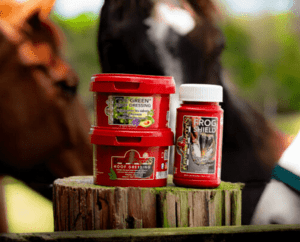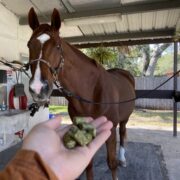So I Want To Buy A Horse At An Auction. Now What?

Editor’s Note: This is the first in a two-part series explaining the ins and outs of the Verden auction at the Hannoveraner Verband, one of the most highly acclaimed European sport horse auctions in the world. Stay tuned for part two on heelsdownmag.com
From Europe to North America, buying horses through an auction setting is fairly common for a variety of disciplines, from Thoroughbred racing to dressage or show jumping. But there are standard rules in place for how buyers can see, evaluate and ultimately bid on a horse. Read on as Heels Down Mag explains how auctions work from the buyer’s perspective.
Riding Horse Auctions
Prospective buyers can view horses available for sale at a designated auction online just like any other horse offered for sale. With the catalog published well in advance to the auction date, the horses are able to be viewed in a short video showing the basic gaits. Those interested in buying are able to choose horses of interest based on their pedigree, photo, and video which are all available online at hannoveraner.com.
Vet Check
Standard veterinarian checks are offered for horses bought through most auction settings. For example, the auctions at the Verband, offer a two-week vet check process.
Most horses arrive the first day from across the street at the Verband’s training barn, where they have been preparing to be sold, while the remainder of the collection arrive from outside stables.
On day one, all horses are identified with Hannoveraner passports and microchips before being jogged on hard ground in a vet check. It is of the utmost importance that the horses are fit and sound for the two weeks ahead. Additionally, all horses have X-rays that potential buyers can view, and the vet staff at the Verband are available to discuss the vetting of each individual horse upon request.
Training
The second day the horses begin training with their designated auction rider. The first days at the Verband are about the horses getting comfortable with their new stables, riders, and in the arenas. The riders take time to work with the horses and familiarize them, both in the warm up and the auction arena. This is a very important part of the process, as most of the horses are between the ages of three and six, and require an experienced handler.
Presentations
Selling presentations begin the first week. All of the horses are warmed up then ridden in the auction ring to be viewed by potential buyers. This allows buyers the opportunity to see how the horses handle the change of atmosphere and to ultimately get a better sense of the horses. The warm up, lunging arenas and stables are all able to be observed to get a holistic, honest view of not only the horses, but also of the auction process.
Throughout the week, potential buyers have the opportunity to ride horses of interest on trial and advisors are available to assist in selecting suitable horses. Those interested are welcome to ask questions of the riders and are welcome to visit the stables to see the horses in the stalls. Videos of the presentations are also posted online in the catalog.
Auction Time
On the last day of the auction process, usually the second Saturday, the horses are auctioned to the highest bidder. The auction arena is filled with customers as the horses enter one last time, one at a time, in numerical order. Horses trot or canter around the arena as bidders fight for the winning bid. Afterward, congratulatory flowers are given to the new owners.
After the Big Day
Some horses leave the Sunday following the auction, especially those that will remain in Germany. Those who are bought outside of the country often will stay additional days while travel arrangements are made. The horses all receive a day of rest on Sunday following the auction. The next week they continue to be ridden by the riders at the Verband until leaving for their homes. However some horses could remain at the Verband for additional training. The training barn at the Verband is located just across the street from the auction stable.


